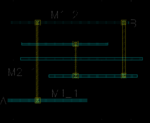BB11
Member level 4

Hello
Can anyone pls tell me, with reference to drawing layouts, wat do you mean by metal1 or any metal in unidirectional or bi directional??.. Does that mean that metal if defined unidirectional(eg. horizontal) can make a connection only in the horizontal direction ????
Thanks in advance
BB
Can anyone pls tell me, with reference to drawing layouts, wat do you mean by metal1 or any metal in unidirectional or bi directional??.. Does that mean that metal if defined unidirectional(eg. horizontal) can make a connection only in the horizontal direction ????
Thanks in advance
BB


